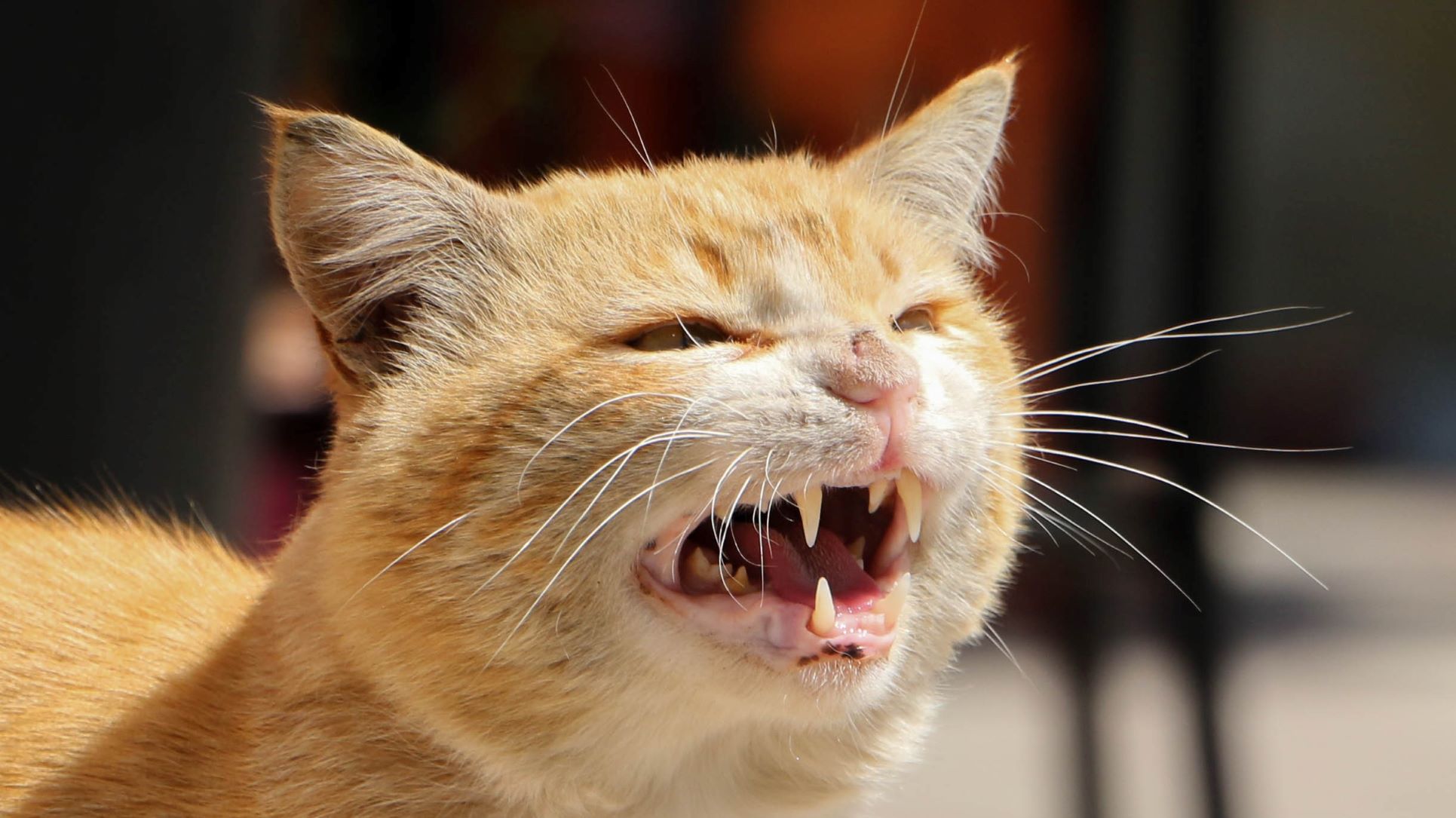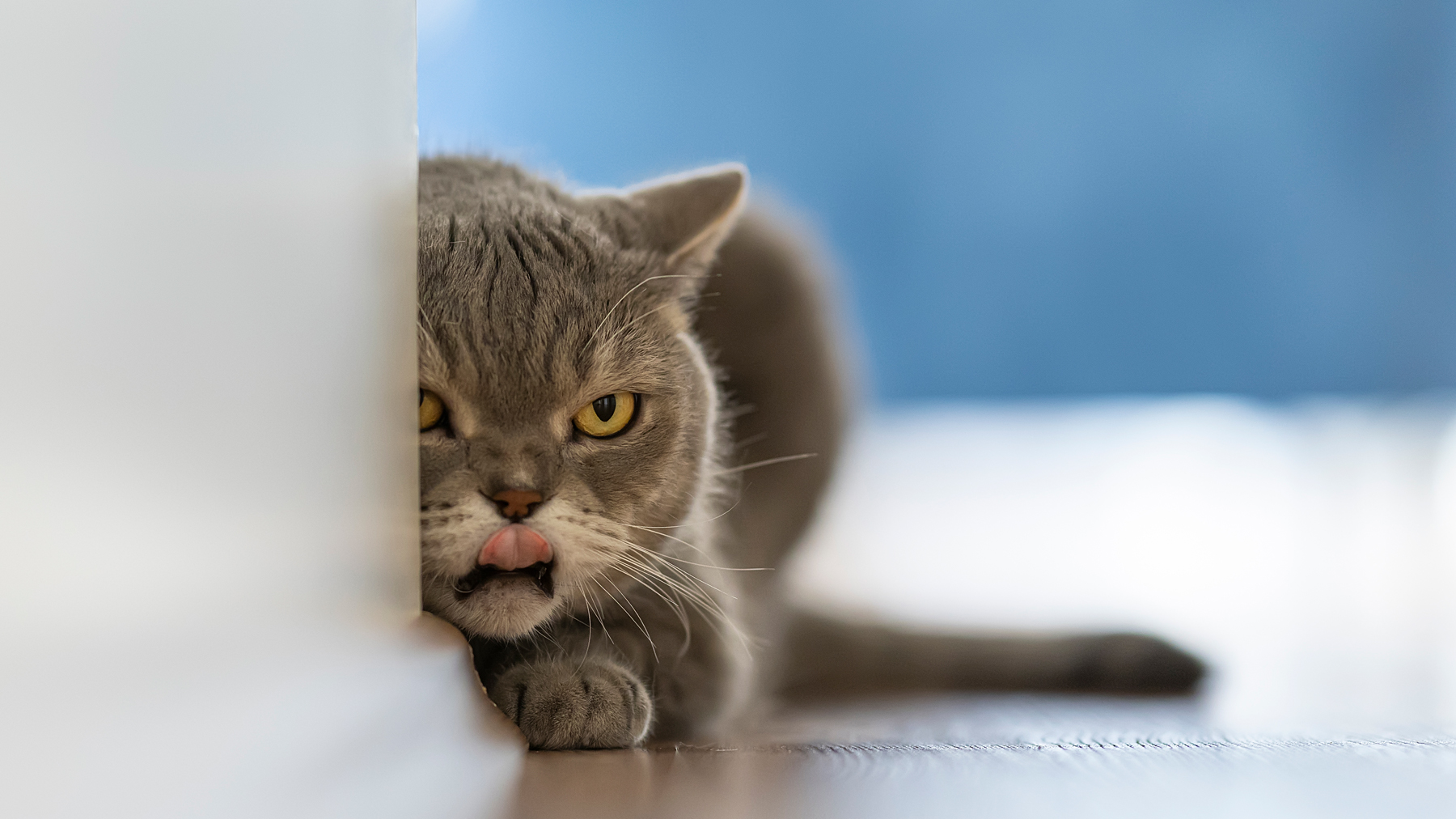How to calm an aggressive cat
Do you have a naughty kitty on your hands? We reveal how to calm an aggressive cat

Trying to figure out how to calm an aggressive cat can feel like a mystery. After all, we don't tend to associate aggression with our feline friends who are usually either aloof and independent, or super attached and affectionate.
So it can be troubling if you find yourself suddenly having to ask questions like 'why does my cat bite me', or scratch me, when they've not behaved like this in the past?Much like humans, aggression is not a natural behavior cats but is rather a response to something.
Food aggression in cats, for example, is often the result of stress, or being part of a multi-cat household. Aggression while being groomed may be due to a cat being scared of being touched or being in pain.
If you're struggling with your cat displaying aggressive behavior, you'll find the below advice helpful when it comes to identifying the potential cause and how you can help your kitty feel calmer. Plus, we spoke with Nicky Trevorrow, behavior manager at Cats Protection, to get her thoughts on when you should seek help.
How to identify aggressive behavior
Cats are highly spirited animals and as a pet parent, it is important to be acquainted with your cat's normal behavior (you are by far the best judge of your pet as you know them the best). When you are aware of their normal habits it is easy to spot more abnormal traits. Many cats have what is often referred to as a mad half hour – zooming around, being a little raucous or rebellious and this mustn't be confused with aggression. A mad half hour or two is quite normal in the feline world and no cause for concern.
Aggression, on the other hand, includes several characteristics encompassing hostility, violence, intimidation, attacking, combativeness and dominating and these are exhibited in distinct ways. Typical signs of aggression demonstrated by cats include the following:
- Flat ears and or whiskers
- Arched back
- Fur (hackles) standing on end
- Hissing
- Spitting
- Scratching
- Growling or shrieking
- Biting
- Swatting
- Exposed claws
- Opened mouth
- Stiff stance
- Tail flicking
- Lying on their back or side with all teeth and claws exposed
What are the causes of aggressive behavior?

It's by identifying the cause of the aggression that you will find your starting point. As International Cat Care states, ‘Aggression is not a diagnosis or a description of a cat’s temperament but a consequence of an emotional state.’
Get the best advice, tips and top tech for your beloved Pets
As our cats can't tell us what made them cross or ticked off it can be difficult to fathom, however, The Cornell Feline Health Centre reports there are nine causes of aggressive behavior. We have summarized these for you here:
Play aggression (common)
Cats, especially youngsters and kittens are extremely playful. Swatting, thrashing of the tail, gentle mouthing, and stalking are all normal in these circumstances. However, they may push a boundary with a fellow feline mate who will put them in their place and this is perfectly acceptable! A return to normal behavior occurs fairly rapidly afterward.
Fear aggression
Fear occurs due to an undesired, new or unpleasant event, trip, person, or place, instigating the aggression.
Petting-induced aggression
The exact reason for this still remains an enigma but petting your cat can induce a swift change from chilled to angry, for example, suddenly grabbing your arm with their paws and exposed claws.
Redirected aggression
Due to frustration, such as a loud noise or seeing another cat outside a window, your feline redirects their frustration as aggression towards you, another person, a fellow pet or an object.
Pain-induced aggression
A cat who is unwell or in pain from illness, injury or surgery will often exhibit pain or feeling ill as aggression. Arthritis in cats is an example of such a condition.
Status-induced aggression
When your cat wishes to show you, another person, cat or animal whose boss, aggressiveness, including standing their ground by blocking paths and doorway entrances, will be displayed to exert their authority.
Territorial aggression (common)
Cats are territorial and show aggression when their environment is threatened or being encroached upon. Both male and females display territorial tendencies by staking a claim on their designated turf by rubbing, spraying and patrolling. The patch they consider theirs can extend from a part of your home to the whole neighborhood.
Maternal aggression
Like most new mothers any threat, perceived or otherwise to their young, will provoke aggressive behavior from the queen to ward off the threat.
Inter-cat aggression (common)
This can occur between any mix of genders, but uncastrated males and feral felines are notoriously known for this behavior. Fighting and aggression between household cats or neutered cats can be more subtle (and less loud!) but dislikes and disagreements between cats is one of the most common causes of aggressive behavior.
How to calm an aggressive cat?

In the first instance, it is essential to have your veterinarian check over your kitty to rule out any underlying medical cause or pain for the behavior, they may also suggest neutering if applicable and be able to help you work out the primary problem or, refer you on to a behaviorist.
Once the cause is understood, measures to rectify it can begin. Note – never intervene with an angry cat, this easily leads to you becoming bitten or scratched which we don’t want. The best thing to do in the moment is not to make eye contact, do not block any escape routes they use and leave them alone until they have re-settled themselves which can take a little while.
The same advice goes for maternal aggression - stay away and let the mom and kittens be.
Another tactic to use in the case of territorial or inter-cat aggression is separation and slow re-introduction and rewarding good (not bad or negative) behavior but as each cause has specific methods to correct it, professional advice should always be sought.
When should you seek help?
Any behavior giving you concern, or worry, should be investigated further by a vet or behaviorist, especially if measures you have or are taking are not solving the problem. As advised by Nicky Trevorrow, Cats Protection’s Behaviour Manager:
“Owners should always seek help for aggressive behaviour in cats as soon as possible. It’s a sign that not all is right in the cat’s world, so it’s best to see it as a cry for help and not take it personally. There may be an underlying medical issue, so this should always be ruled out first. A common medical reason is pain, and unfortunately, cats are masters at masking signs of pain, so it can easily go undetected. If the vet rules out medical reasons, then they may refer onto a qualified behaviorist from the Animal Behaviour and Training Council. They can come up with a detailed behavior modification plan to address the underlying motivation and hopefully resolve the situation.”
To find a feline behaviorist ask your veterinarian or consult the following resources:
USA
American College of Veterinary Behaviorists
Animal Behavior Society International
Association of Animal Behavior Consultants
UK
Association of Pet Behavior Counselors
Fellowship of Animal Behavior Clinicians
Animal behavior and Training Council
Are you concerned about cat play biting? This feature has everything to know. If you're wondering how to discipline a cat, our vet's guide has some helpful advice. Or, learn 10 signs of an aggressive cat.

Nicky Trevorrow is the Cats Protection’s Behaviour Manager, the UK's largest feline welfare charity who help an average of 166,000 cats and kittens every year. They have a network of over 210 volunteer-run branches and 34 centres. Since 1927 they have helped cats across the UK and helped people to better understand their needs. Their vision is a society where every cat has their best possible life because they are protected, cared for and understood by everyone.
Annaliese qualified as a veterinary nurse from Edinburgh and went on to attain a diploma in advanced veterinary nursing in surgery from London. Throughout this time, she worked in both small and mixed veterinary practices and gained head nurse status. Responsible for training other veterinary nurses she also ran the nursing department, nurse clinics, and patient care protocols.
She has looked after 1,000s of patients and owners and created new higher standard nursing regimes, whilst specializing in surgery and anesthesia. After being asked to co-author multiple veterinary nursing textbooks, Annaliese continued to write for further mainstream publications in the UK and USA and after twenty-plus years in both the veterinary and pet care professions, she hung up her scrub suit and now writes full-time.

